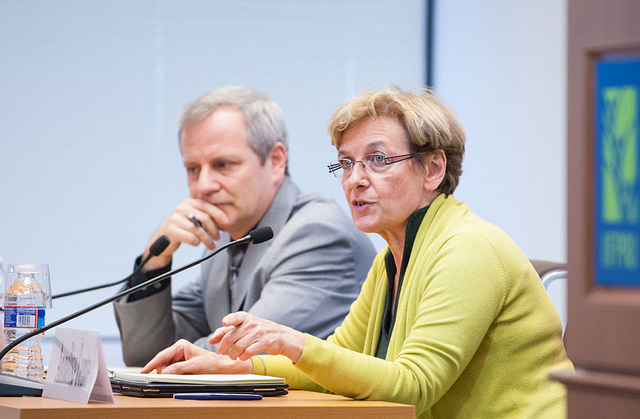IFPRI and others have extensively evaluated social safety net programs in developing countries that provide recipients with cash, food, or vouchers, but there have been almost no evaluations of how those transfers stack up when compared against each other. A new study by IFPRI and the UN World Food Programme (WFP) assesses the impact of these intervention types—and also the most cost-effective ways of delivering those transfers. The findings were presented at a recent seminar at IFPRI’s main office in Washington, DC.
The three-year collaboration between IFPRI and WFP compared the relative costs and benefits of assistance programs that provided the same value of cash, food baskets, or supermarket vouchers in four countries: Ecuador, Niger, Uganda, and Yemen. John Hoddinott, deputy director of IFPRI’s Poverty, Health, and Nutrition Division, detailed the study’s design and randomized sample populations. Holding all other factors constant across the four countries—including the number of participants, transfer value and ease with which participants received their benefits, the study could attribute changes in participants’ food security indicators solely to the type of assistance received.
The results, which Hoddinott reiterated should not be generalized given the small scale and short duration of the six-month evaluation, may surprise some.
Findings revealed that there is no one “right” transfer modality. The relative effectiveness of different modalities depends heavily on contextual factors such as the severity of food insecurity and the thickness of markets for grains and other foods. In three countries (Ecuador, Uganda, Yemen), cash had a relatively larger impact on improving dietary diversity as did vouchers in Ecuador, but in the fourth country (Niger), food had a larger impact on dietary diversity. Cash assistance was always significantly more cost-effective to deliver. In fact, researchers determined that if they repeated the study, but only distributed cash, they could feed an additional 32,800 people with the same project budget.
Thankfully, international aid is no longer based on a “one-size-fits-all, in-kind” solution, according to Annalisa Conte, Deputy Director of WFP’s Policy, Programme, and Innovation Division, and a new business model for some of WFP’s assistance programs is proof. Called “the hybrid,” it allows relief programs to shift from market-based to in-kind assistance and vice versa, by keeping a close eye on local market supply and prices. “This way we can provide assistance to our beneficiaries without creating any distortion or harm to those that are not beneficiaries,” Conte explained.
Related Materials







